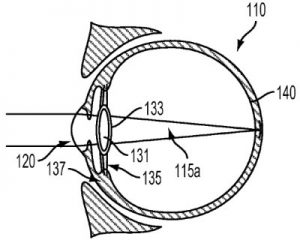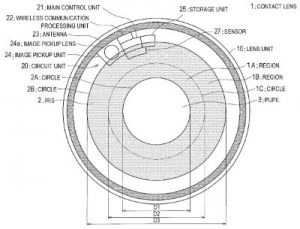In the very first episode of the ABC television show Marvel’s Agents of S.H.I.E.L.D., the character of Mike Peterson, a seemingly ordinary man with extraordinary abilities, is introduced to the audience. Mike becomes the Marvel Cinematic Universe’s version of the cybernetic soldier known as Deathlok. In the middle of the show’s first season, Mike is kidnapped and wakes up to find himself badly injured from a traumatic blast and receiving text messages on a lens implanted into his eye. It’s through this lens that he receives messages from a mysterious party that is trying to use him to infiltrate S.H.I.E.L.D.
This summer on IPWatchdog, we’re investigating the intersection between technological fact and comic book fiction in our Superhero Tech series. We’ve already covered bullet-stopping foams which mimic Captain America’s shield as well as the high-tech armor suit technologies employed by Tony Stark’s Iron Man. The third season of Agents of S.H.I.E.L.D. may have just wrapped, but we will revisit this topic area as the cinematic universes for both Marvel and DC Comics continue to expand throughout the summer and over the coming years.
 If you were to ever wake up and find that messages were being transmitted directly to your eye, as was the case with Mike Peterson, you might be able to blame it on Alphabet Inc. (NASDAQ:GOOGL) Alphabet subsidiary Verily Life Sciences filed a patent application recently published by the U.S. Patent and Trademark Office as U.S. Patent Application No. 20160113760, filed under the title Intra-Ocular Device. It would protect a method involving injecting fluid into an eye’s lens capsule after the lens has been removed, positioning an intra-ocular device having an electronic lens providing optical power within that fluid and then solidifying the fluid which couples the lens capsule to the intra-ocular device. The resulting artificial lens could be controlled to provide different optical powers for focusing on objects at various distances, replacing a natural lens which may have degenerated with time or affected by congenital or age-related diseases. Nothing in the patent application’s claims speaks to the ability to send and receive text messages via the artificial lens, but if such a technology is going to exist this seems like a step along the technological evolution.
If you were to ever wake up and find that messages were being transmitted directly to your eye, as was the case with Mike Peterson, you might be able to blame it on Alphabet Inc. (NASDAQ:GOOGL) Alphabet subsidiary Verily Life Sciences filed a patent application recently published by the U.S. Patent and Trademark Office as U.S. Patent Application No. 20160113760, filed under the title Intra-Ocular Device. It would protect a method involving injecting fluid into an eye’s lens capsule after the lens has been removed, positioning an intra-ocular device having an electronic lens providing optical power within that fluid and then solidifying the fluid which couples the lens capsule to the intra-ocular device. The resulting artificial lens could be controlled to provide different optical powers for focusing on objects at various distances, replacing a natural lens which may have degenerated with time or affected by congenital or age-related diseases. Nothing in the patent application’s claims speaks to the ability to send and receive text messages via the artificial lens, but if such a technology is going to exist this seems like a step along the technological evolution.
Verily Life Sciences was renamed from Google Life Sciences last December in the wake of Google’s transformation into the new Alphabet holding company for Google’s vast tech empire. The subsidiary reportedly leased a 400,000-square foot facility in South San Francisco in February and hopes to shift 400 jobs to the new facility by the end of this year. The San Francisco Business Times reported in early May that Verily was ramping up hires of cell biologists as well as hardware and software developers. Remarks from American Optometric Association published by MedCity News indicates that the product is likely a few years away from consumer markets but the technology would be revolutionary for those suffering from naturally caused vision impairment.
Deathlok’s artificial lens doesn’t simply superimpose text over Mike Peterson’s field of vision. It’s also capable of transmitting video to the wearer, as is seen late in season 1 of Agents of S.H.I.E.L.D. when Mike Peterson is shown a video of his son for the first time since they were separated. Although Google’s implantable lens wouldn’t have this capability, a contact lens currently in development at Tokyo-based Sony Corp. (NYSE:SNE) would be able to handle that job.
 This April, the USPTO published U.S. Patent Application No. 20160097940, entitled Contact Lens and Storage Medium. It would protect a contact lens having an image pickup unit to capture an image of a subject and an image pickup control unit charged with recording, storing and displaying video. Those wearing the contact lens could initiate the recording function by intentionally closing their eyes for half a second, which is longer than the human eye usually takes to blink. To provide video which doesn’t include momentary dark spots caused by natural blinking, recording controls edit out the dark spaces for a more continuous viewing experience. The technology can also process information from a tilt sensor which can identify that a contact lens has rotated during the course of recording a video and the stored video can be adjusted to compensate for this.
This April, the USPTO published U.S. Patent Application No. 20160097940, entitled Contact Lens and Storage Medium. It would protect a contact lens having an image pickup unit to capture an image of a subject and an image pickup control unit charged with recording, storing and displaying video. Those wearing the contact lens could initiate the recording function by intentionally closing their eyes for half a second, which is longer than the human eye usually takes to blink. To provide video which doesn’t include momentary dark spots caused by natural blinking, recording controls edit out the dark spaces for a more continuous viewing experience. The technology can also process information from a tilt sensor which can identify that a contact lens has rotated during the course of recording a video and the stored video can be adjusted to compensate for this.
Contact lenses and other techniques for improving upon visual impairments have come a long way since the irritating glass contacts seen in the 17th century. Over the past few years, we’ve seen a lot of electronic contact lenses being developed whenever we feature New Brunswick, NJ-based medical device developer Johnson & Johnson (NYSE:JNJ) here on IPWatchdog. Last June, we covered improvements to implantable bionic devices which were able to restore some very basic vision to blind patients. Cybernetic super-soldiers may be fictitious but the high-tech artificial lens implanted onto Agents of S.H.I.E.L.D.’s Mike Peterson could become a distinct reality in the future.

![[IPWatchdog Logo]](https://ipwatchdog.com/wp-content/themes/IPWatchdog%20-%202023/assets/images/temp/logo-small@2x.png)


![[Advertisement]](https://ipwatchdog.com/wp-content/uploads/2024/04/UnitedLex-May-2-2024-sidebar-700x500-1.jpg)
![[Advertisement]](https://ipwatchdog.com/wp-content/uploads/2024/04/Artificial-Intelligence-2024-REPLAY-sidebar-700x500-corrected.jpg)
![[Advertisement]](https://ipwatchdog.com/wp-content/uploads/2024/04/Patent-Litigation-Masters-2024-sidebar-700x500-1.jpg)

![[Advertisement]](https://ipwatchdog.com/wp-content/uploads/2021/12/WEBINAR-336-x-280-px.png)
![[Advertisement]](https://ipwatchdog.com/wp-content/uploads/2021/12/2021-Patent-Practice-on-Demand-recorded-Feb-2021-336-x-280.jpg)
![[Advertisement]](https://ipwatchdog.com/wp-content/uploads/2021/12/Ad-4-The-Invent-Patent-System™.png)






Join the Discussion
No comments yet.